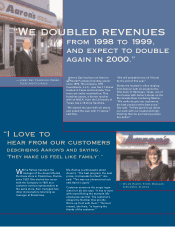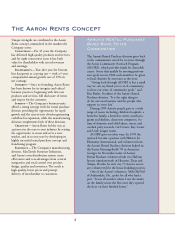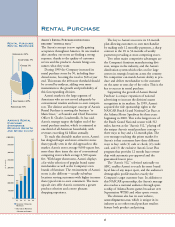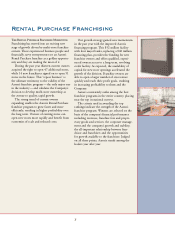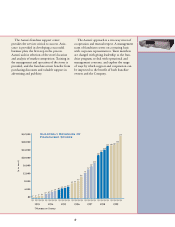Aarons 1999 Annual Report Download - page 16
Download and view the complete annual report
Please find page 16 of the 1999 Aarons annual report below. You can navigate through the pages in the report by either clicking on the pages listed below, or by using the keyword search tool below to find specific information within the annual report.
14
Management’s Discussion and Analysis
of Financial Condition and Results of Operations
Change in Fiscal Year End
During 1995, the Company changed its fiscal year end
from March 31 to December 31, which resulted in a nine
month fiscal year ended December 31, 1995. The decision
to change the fiscal year end was made for more convenience
in both internal and external communications. To aid com-
parative analysis, the Company has elected to present the
results of operations for the twelve months ended December
31, 1995 (unaudited), along with the years ended December
31, 1999, December 31, 1998, December 31, 1997 and
December 31, 1996.
Results of Operations
Year Ended December 31, 1999 versus Year Ended
December 31, 1998
Total revenues for 1999 increased $57.7 million (15.2%) to
$437.4 million compared to $379.7 million in 1998 due
primarily to a $28.9 million (10.0%) increase in rentals and
fees revenues, plus a $26.4 million (139.1%) increase in
non-retail sales. Of this increase in rentals and fees revenues,
$32.7 million was attributable to the Aaron’s Rental Purchase
division. Rentals and fees from the Company’s rent-to-rent
operations increased $2.0 million excluding $5.8 million of
rentals and fees from the Company’s convention furnishings
division, which was sold in the fourth quarter of 1998.
Revenues from retail sales decreased $280,000 (.4%) to
$62.3 million in 1999 from $62.6 million for the same
period last year. The decrease was the result of new sales in
the rent-to-rent division decreasing and the discontinued sale
of prepaid cellular air time in the rental purchase division.
Non-retail sales, which primarily represent merchandise
sold to Aaron’s Rental Purchase franchisees, increased
$26.4 million (139.1%) to $45.4 million compared to
$19.0 million for the same period last year. The increased
sales are due to the growth of the franchise operations
coupled with the addition of a new distribution center.
Other revenues for 1999 increased $2.7 million (30.5%)
to $11.5 million compared to $8.8 million in 1998. This
increase was attributable to franchise fee and royalty income
increasing $1.8 million (25.3%) to $9.1 million compared to
$7.3 million last year, reflecting the net addition of 19 new
franchised stores in 1999 and increasing operating revenues
at mature franchised stores.
Cost of sales from retail sales increased $868,000 (2.0%)
to $45.3 million compared to $44.4 million, and as a per-
centage of sales, increased slightly to 72.6% from 70.9%
primarily due to product mix. Cost of sales from non-retail
sales increased $24.8 million (140.8%) to $42.5 million
from $17.6 million, and as a percentage of sales, increased to
93.5% from 92.9%. The reduced margins on non-retail sales
was primarily the result of lower margins on certain products
sold to franchisees.
Operating expenses increased $12.2 million (6.4%) to
$201.9 million from $189.7 million. As a percentage of total
revenues, operating expenses were 46.2% in 1999 and 50.0%
in 1998. Operating expenses decreased as a percentage of
total revenues between years primarily due to increased
revenues in the Aaron’s Rental Purchase division and the sale
of the Company’s convention furnishings division which
had higher operating expenses than traditional rent-to-rent
and rental purchase operations.
Depreciation of rental merchandise increased $13.2
million (14.8%) to $102.3 million, from $89.2 million, and
as a percentage of total rentals and fees, was 32.2% compared
to 30.8% in 1998. The increase as a percentage of rentals and
fees is primarily due to a greater percentage of the Company’s
rentals and fees coming from the Aaron’s Rental Purchase
division which depreciates its rental merchandise at a faster
rate than the rent-to-rent division.
Interest expense increased $544,000 (15.3%) to $4.1
million compared to $3.6 million. As a percentage of total
revenues, interest expense remained unchanged at 0.9%.
The Company manages its exposure to changes in short-
term interest rates, particularly to reduce the impact on its
floating-rate term notes, by entering into interest rate swap
agreements. The counterparties to these contracts are high
credit quality commercial banks. Consequently, credit risk,
which is inherent in all swaps, has been minimized to a large
extent. Interest expense is adjusted for the differential to be
paid or received as interest rates change. The effect of such
adjustments on interest expense has not been significant.
The level of floating-rate debt fixed by swap agreements
was $40.0 million during the year and the Company does
not expect a significant change in this amount in 2000.
Accordingly, the Company does not believe it has material
exposure of potential, near-term losses in future earnings,
and/or cash flows from reasonably possible near-term
changes in market rates.


